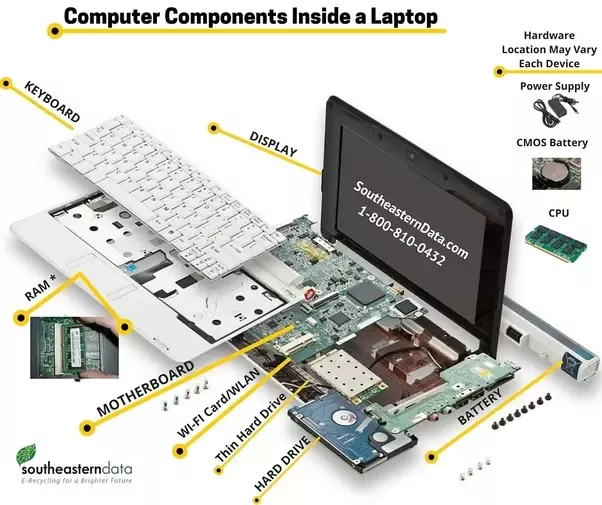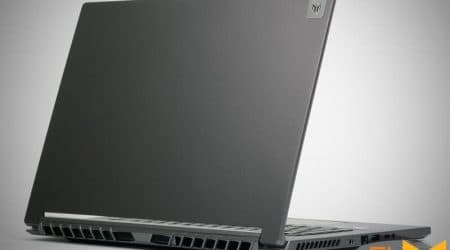


Technology and its progress have become an essential companion of our day-to-day lives. Among the technology brands that have made a significant impact, HP, particularly its laptop segment, holds a distinctive place. Yet, a question that often intrigues tech enthusiasts is: where are these devices manufactured?
We will dig deeper to unmask the birthplace of HP’s laptops, a well-acknowledged brand with a global presence and a significant player in the world of personal computing. Our investigation into the genesis of HP laptopswhere they’re conceived and constructedwill help you better comprehend the quality and reliability linked with this name.
Understanding the origins of HP laptops is an exciting way to appreciate the brand-dedication in ensuring each laptop rolls out to meet the highest standards. This article aims to shed light on the journey of HP laptops from the assembly line to your desk, unraveling the creation and the elements that contribute to their global recognition.
The Genesis of the HP Laptop
The inception history of HP laptops can be traced back to the development of Hewlett-Packard Company. Bill Hewlett and Dave Packard, two electrical engineering graduates from Stanford University, founded the company in 1939. Initially, the company engaged primarily in the production of electronic testing equipment. It was not until a few decades later that it ventured into computer manufacturing.
Entry into the Computing Industry
The company made its debut in the computing industry in the 1960s with its HP 2116A, an instrument controller, followed later by production of the 9100A, a desktop calculator. It was in the late 70s that HP majorly broke into personal computing with the introduction of the HP-85 series.
The venture into laptops for Hewlett-Packard came in later in the 1980s with the launch of the HP-110, also known as the HP Portable. This is credited as the first laptop made by HP. Although it has a vastly different design and features compared to the modern sleek HP laptops we are accustomed to today, it marked the beginning of HP’s journey into laptop manufacturing.
Ever since, HP has been one of the pioneers in the industry, renowned for its technological innovation, reliability, and enduring commitment to providing quality devices for personal and business use.
The Evolution of HP Laptops
While the earliest HP computers were nothing more than simple calculators, the brand has since evolved to produce some of the world’s leading laptops. The HP Portable, as basic as it was at the time, laid the groundwork for the future of laptop designs.
HP’s continuous innovation over the years has seen the introduction of ground-breaking products, shaping the trajectory of technology advancement in the computing world. Some of the landmark products included the touchscreen laptops, ultra-thin sleek designs, and powerful performance gaming laptops.
HP’s dedication to quality and innovation continues to place it among the world leaders in laptop manufacturing. So, although HP has a history dating back several decades, it still maintains a cutting-edge approach, continually embracing technological changes and setting trends in the laptop industry.
Global Manufacturing Locations of HP
In the tech world, Hewlett-Packard (HP) is a globally recognized name, known for its extensive range of laptops and other digital devices. With its headquarters based in the United States, HP conducts manufacturing operations on an international scale. To keep up with global demands and supply chain efficiencies, HP has established several principal manufacturing locations around the globe.
Main Production Facilities of HP Worldwide
HP has built up a considerable manufacturing footprint not only within the US, but also in various other locations around the world. Some of the prominent hubs include:
- Asia: HP has a considerable manufacturing presence in various Asian countries, including China, India, and Singapore. These centers are pivotal to the HP production line, creating vast numbers of laptops for global distribution.
- Americas: Beyond its home turf of the United States, HP has manufacturing locations in Brazil and Mexico. These facilities contribute significantly to the production of HP laptops.
- Europe: In Europe, HP’s manufacturing operations are predominantly conducted in Poland. But it also has other facilities dotted around the region.
It’s also important to note that, while these are HPs major manufacturing facilities, the company also outsources certain parts of its production process to other countries to reduce costs and ensure efficiency.
In conclusion, while Hewlett-Packard began as a small-scale operation in a garage in Palo Alto, it has grown to be a truly global entity with major manufacturing hubs located throughout the world. Its widespread presence ensures it can meet the needs of its global customer base efficiently and effectively.
Deciphering the Supply Network and Production Process of HP
Grasping the complex and extensive supply chain system and production process deployed by Hewlett Packard (HP) is crucial to understand where HP laptops are produced. HP has built a global network of suppliers and manufacturers, with operations scattered across various continents.
The Supply Chain
The supply chain system of HP is multi-layered and involves several stakeholders. Being in the electronics sector, HP relies heavily on sourcing parts from various suppliers. These components come from a range of suppliers located in different parts of the world, and HP goes to great lengths to ensure that its suppliers adhere to stringent quality standards and regulations. Major items that HP sources include microprocessors, hard drives, RAMs, and other electronic components essential for laptop production.
The Manufacturing Process
The production journey of HP laptops is also equally detailed and meticulous. Once all the components are sourced, they are sent to the manufacturing factories. These factories, located in various parts of the world including China, Mexico, and Europe, are where the actual assembly of the laptops takes place. A high level of precision and attention to detail is required during the assembly process to ensure that the final product meets the high standards of HP.
After assembly, laptops undergo a series of rigorous tests to assure quality. Only the laptops that pass these tests are packed and prepared for shipping. HP uses its global distribution network to distribute these laptops to the various markets it operates in around the world. This includes direct sales from HP, as well as sales through various partners and resellers.
It’s crucial to note that HP is constantly reevaluating and refining its supply chain and production processes. It’s a part of their commitment to deliver high-quality products while simultaneously working towards reducing their environmental footprint and promoting sustainable practices in their operations.
A Detailed Look into the Production of Hewlett Packard Laptops in China
Overview of Hewlett Packard Laptop Production in China
One of the renowned manufacturers of laptops globally, Hewlett Packard, commonly referred to as HP, has major production lines and manufacturing facilities situated in China. The appeal of China to HP is not unexpected considering the country’s high technological competence, readily available labor, and well-developed logistics infrastructure that supports high-scale production.
The Capital of HP’s Manufacturing Operations
The technological city of Chongqing stands out as the epicenter of HP’s laptop production in China. This strategic location boasts of three of the biggest HP factories. Besides the benefit of mass production, being in Chongqing offers a convenient connection to other parts of Asia, Europe, and Africa through well-established railway lines.
The Production Process
Leveraging cutting-edge technology, skilled labor, and a process-driven manufacturing approach, HP’s China plants produce millions of high-quality laptops each year. The production process commences with assembling the motherboards and gradually progresses through several stages including installing processors, integrating hard disks, assembling the housing, and installing operating systems. To ensure top-notch quality, the laptops undergo intricate testing before leaving the factory line.
- Environmental and Social Responsibility
- Challenges and Opportunities
Taking into account its global impact, HP maintains a high level of social and environmental responsibility in its China plants. These measures range from reducing carbon emissions, ensuring waste reduction, to upholding suppliers’ labor and environmental standards.
Despite being a significant player in the laptop market, HP faces certain challenges in China, such as fluctuating labor costs, logistical issues, and trade disruptions. However, the increasing demand for laptops, especially during the Covid-19 pandemic, presents a burgeoning opportunity. HP continues to strategize and adjust to meet current global needs and upcoming trends in the technology market.
The Role of the United States in the Production of HP Laptops
The United States has made crucial contributions to the production of HP laptops, with the origins of this tech giant rooted in Palo Alto, California. Over the years, the U.S. has served both as a key market for the company and a hub for its innovative endeavors, driving research, design, and certain aspects of production.
Fostering Innovation
The American knack for innovation has, without a doubt, played a vital role in HP’s growth as a global leader in the tech world. The company’s research and development labs situated in the United States light the path for the next-generation of laptops. This, in turn, helps the company create exclusive, cutting-edge features, setting HP laptops apart from the competition.
Influencing Design Concepts
U.S.-based design teams have significantly influenced the look and feel of HP laptops, crafting aesthetically pleasing and functional machines that meet the needs and preferences of the market. From slim, lightweight laptops for people on-the-go to high-performance machines for gamers or creative professionals, the diversity of design concepts fostered in the U.S. is evident across HP’s product range.
Production and Quality Assurance
While the actual manufacturing of HP laptops primarily takes place overseas, final assembly for a portion of their custom-order laptops transpires in the United States. These facilities also play a critical role in testing and quality assurance, ensuring that every laptop leaving the assembly line meets HPs stringent standards for performance, reliability and craftsmanship.
Key Economic Contributions
The economic footprint of HP within the U.S. is substantial. The firm is a known job creator and contributes significantly to Americas tech industry. HP’s operations represent a sizeable investment in the U.S. economy, supporting a wide range of industries from part production to logistics and retail.
Overall, while the physical manufacturing of HP laptops may largely occur in other parts of the globe, the United States still plays an important, multi-faceted role in their production process. From nurturing innovation to impacting design, assuring quality and contributing economically – the influence of the U.S on HP laptop production is significant.
A Deep-Dive into the HP Laptop Production Process in Mexico
Let’s journey into the heart of HP’s laptop production operations in Mexico. Computers from HP, a globally recognized tech giant, are assembled in this tropical country, with the bulk of their assembly line located here. The focus of this article is to give a detailed description of the various stages through which these laptops pass before they are ready for the market.
The Journey of an HP Laptop to the Market
The production process begins with the assembly of the motherboard, the brain of the laptop. Microchips, processors, and other significant components are carefully assembled on the board. The precision and accuracy required during this stage cannot be overstated. It is at this stage that the laptop’s performance and functionality are determined.
Next, the assembled motherboards are connected to the laptop screens. This stage in the process involves a great deal of manual labor and requires workers to attach the screen to the laptop shell. Extreme care is taken to ensure that the screens are attached without causing any damage.
The final stage of the assembling line is testing. Every laptop is put through rigorous testing phases to ensure that it is functioning properly. This involves booting the laptop, checking the display functionality, testing the keyboard and other peripheral devices, and running general performance software tests.
- Assembly of the Motherboard
- Connecting the Screen
- Testing the Finished Product
In a nutshell, the production line for HP laptops in Mexico is a testament to modern technology’s precision and efficiency. Despite the complexity and meticulous nature of the process, the assembly line manages to produce high-quality laptops that meet the diverse needs of consumers worldwide.
Understanding the Manufacturing of HP Laptops in India
The production of HP laptops within the borders of India stands as both a critical aspect of the country’s technology sector and the global operations of Hewlett-Packard. This American multinational company has shown keen interest in the Indian market, and this is portrayed in its localized production policies.
The Genesis of HP Laptop Manufacturing in India
The journey of Hewlett-Packard’s laptop manufacturing in India began with a keen interest in the nation’s rapidly growing technology sector. Recognizing the potential, HP established its manufacturing plants in the country. The company’s decision was strategic: lower manufacturing costs, readily available workforce, and proximity to a vast consumer market.
As part of the production chain, HP laptops are designed in HP’s global headquarters in the USA and manufactured in India. This implies that the key components are shipped from the USA and other parts of the world, then assembled in the Indian manufacturing plants.
Significance of HP Laptop Production in India
Apart from contributing significantly to HP’s regional profits, the local production of HP laptops in India has peripheral benefits. It directly contributes to job creation and skill development among the local workforce. Moreover, since a significant portion of these laptops is consumed within India, it also meets the demands of local consumers and businesses. Furthermore, the localized manufacturing process also allows HP to eliminate unnecessary shipping costs and tariffs, ultimately reflecting the product pricing.
- Job Creation: With various manufacturing units in the country, HP has created numerous jobs in India, contributing to the nation’s economy.
- Skill Enhancement: Through their detailed process of laptop manufacturing, HP contributes to the development and enhancement of skills among the local population.
- Consumer Market: India, being a vast market for laptops and related technology products, benefits from the localized production of HP laptops from the perspective of availability and pricing.
- Cost-Effective: Producing laptops within India’s boundaries also makes it more cost-effective for HP, further contributing to its profitable operations.
In essence, the production of HP laptops in India is a win-win for both Hewlett-Packard and India. It stands as a critical aspect of Hewlett-Packard’s global supply chain, considering the growing technology landscape and vast consumer market in the country.
Ensuring Excellence in HP Laptop Production
Stringent Quality Control System
When it comes to the production of HP laptops, a particularly rigorous quality control process is followed. Each model of laptops goes through a meticulous checking process to ensure the highest levels of performance and reliability. The robustness of these devices is attributed to the careful scrutiny as part of the quality assurance process. From the sourcing of raw materials to the final assembly, every process is supervised by a team of highly skilled professionals.
Vigorous Testing Procedures
HP is renowned for implementing vigorous testing procedures to ascertain that every laptop leaving the production line meets the company’s stringent quality standards. These procedures serve to identify and rectify any potential issues before the product reaches the end user.
- Performance Testing: This involves putting the system through a variety of scenarios to ensure its capability to handle multiple processes simultaneously.
- Durability Testing: It assesses the device’s ability to withstand continuous use and hold up under varying conditions over a period of time.
- Usability Testing: It evaluates the ease of use and accessibility of various features to provide a seamless user experience.
Use of Cutting Edge Technology
By leveraging cutting-edge technology, HP commits to producing laptops that are not only durable but also blended with innovation. Advanced automation tools are employed to perform the in-depth tests, while manual checking is conducted to leave no room for errors.
In conclusion, each HP laptop is created through a meticulous production process backed by a rigorous quality assurance and testing procedure. This ensures that all products live up to the brand’s high-quality standards, providing consumers with reliable and high-performing devices.
Localization’s Influence on the Manufacturing of HP Laptops
The process of producing Hewlett-Packard (HP) laptops involves an extensive global network, underscoring the importance of localization strategies. Companies like HP recognize the vital role these localization strategies play not only in making their operations more efficient, but also in ensuring product acceptance and market penetration in various regions.
Localization strategies can encompass multiple factors, from production and assembly to the final product’s design and marketing. By aligning their manufacturing processes with the local regulations, resources, and market demand, HP can effectively enhance their production efficiency and ensure their laptops are well-received by distinct markets.
Production and Assembly
By examining local industry policies, workforce capabilities, and infrastructure, HP can position their manufacturing facilities in optimal locations worldwide. This reduces logistics costs, ensures a steady supply of raw materials, and harnesses the skills of local talent. For instance, technical talents can be leveraged in regions where advanced manufacturing technology is booming. This not only enhances the productivity but also ensures the produced laptops meet the evolving technology standards.
Product Design and Marketing
Localization also plays a crucial role in product design and marketing. By understanding local user habits, preferences, and needs, HP can design laptops that strike a chord with local consumers. Therefore, the configuration, aesthetics, and function of HP laptops can vary widely from region to region. Similarly, localized marketing efforts ensure that the way HP laptops are promoted resonates with the cultural context and aesthetic taste of the target consumers in different countries. Market research, local collaboration, and adopting cultural subtleties are all integral in these efforts.
In summary, localization strategies in HP’s laptop manufacturing result in tangible benefits for both the company and the end-users. This localized approach ensures HP laptops are not only globally available, but they are also relevant and appealing to the diverse consumer segments around the world.
Understanding the Ecological Consequences Linked with the Manufacturing Process of HP Laptops
The production of HP computers, just like all technological items, leads to particular ecological ramifications. During their creation, significant environmental resources are used, and throughout their operational lifespan, energy consumption is consistent. Furthermore, their disposal can also lead to numerous environmental issues if not handled appropriately.
At the initial phase, the development of HP laptops necessitates the extraction of critical resources. These include valuable minerals and metals such as aluminum, copper, and gold.
Manufacturing Process
The creation of HP laptops also involves the emission of harmful greenhouse gases. Manufacturing plants, which are primarily located in Asian countries, run on electrical energy typically generated from fossil fuels.
Power Usage
Due to their constant requirement for electricity to function, laptops contribute to global energy consumption. This offshoot is particularly critical for power-thirsty models with high-performance specifications that go beyond essential customer requirements.
Disposal Concerns
Finally, the dilemma amplifies at the end of the laptops’ lifespan. The majority of the electronic garbage, known as e-waste, isn’t disposed of properly and can harm the environment due to the various toxic elements they contain, including lead and mercury.
HP identified these concerns and has made several strides to mitigate the environmental impact of their laptops. These include developing energy-efficient models, supporting recycling initiatives, and seeking out ways to reduce harmful manufacturing byproducts. Nonetheless, a comprehensive understanding of the environmental effects of HP laptop production is essential not just for ecological reasons but for the future evolution of the technology.
A Glimpse into the Future: Examining the Road Map and Forecasts for Production of HP Laptops
Stepping into the future, HP has substantial plans to revolutionize its laptop manufacturing processes. Over the years, HP has established its dominance in the technology industry, characterized by progressive and forward-thinking manufacturing approaches. Notably, the future of HP’s laptop production is predisposed to be even more captivating.
The corporation nurtures the dream of making its laptops lighter, faster, and more efficient. Accordingly, HP plans to exploit technological advancements such as Artificial Intelligence (AI), nanotechnology, and the Internet of Things (IoT). By integrating these technologies into its manufacturing processes, HP aims to create innovative laptops that exceed customer expectations.
Brief Peek at the Forecasts for HP Laptop Manufacturing
One of the significant predictions is the incorporation of AI in the entire production process. This powerful technology would assist in improving quality control, preventing machine failures, and reducing operational costs. AI is anticipated to expedite decision-making processes, enhance product quality, and promote a more efficient use of resources.
Besides AI, HP envisages a future where nanotechnology profoundly influences laptop manufacturing. This impressive technology would allow HP to build smaller, more powerful, and energy-efficient devices. The company predicts that nanotechnology will enable it to develop laptops with superior performance and longer battery life.
Moreover, HP intends to adopt the IoT in its manufacturing processes. This would make HP’s factories smarter and more connected, leading to enhanced productivity and operational efficiency. IoT would also provide real-time monitoring and analytics, which would aid in reducing manufacturing defects and improving product quality.
- AI enabled Quality control and machine maintenance.
- Nanotechnology for compact and energy efficient laptops.
- IoT for smarter, more productive factories.
In conclusion, HP is poised to redefine the future of laptop manufacturing. It aspires to leverage AI, nanotechnology, and IoT to manufacture innovative, high-quality laptops that cater to the evolving needs of consumers. The future of HP laptop production exhibits vast potential, promising a transformative phase for the company and the technology industry as a whole.
FAQ Where is hp laptop made:
What are HP’s future plans for laptop manufacturing?
HP’s future plans involve incorporating the latest technologies, going beyond the traditional design and functionality. They aim to make laptops thinner, lighter, and more energy-efficient. They are also working towards integrating advanced virtual and augmented reality into their devices.
Does HP plan to introduce more eco-friendly laptops in the future?
Yes, sustainability is a key focus for HP. They plan to reduce their environmental footprint through recycling programs and by producing laptops with energy-efficient features and renewable materials.
Is HP planning on integrating AI technology into its future laptops?
Yes, HP sees immense potential in AI and plans on integrating it into their future laptops. They aim to enhance user experience through personalized recommendations, voice recognition, and sophisticated data processing capabilities.
Does HP plan on introducing laptops tailored towards gaming in the future?
Yes, recognizing the growing market for gaming laptops, HP plans to expand its OMEN series. The future laptops under this series will have advanced graphic capabilities, high-speed processors, and improved cooling systems to cater to gaming needs.
What advances in screen technology does HP anticipate in laptop manufacturing?
HP anticipates significant advances in screen technology. They predict future laptops will feature more vibrant and lifelike displays, with better viewing angles, higher resolution, and potentially even flexible or foldable screens.
Does HP predict any changes in laptop battery technology in the future?
HP predicts considerable improvements in battery technology, aiming for future laptops to have longer battery lives and shorter charging times. They are also planning on exploring technology such as solar charging for their devices.






